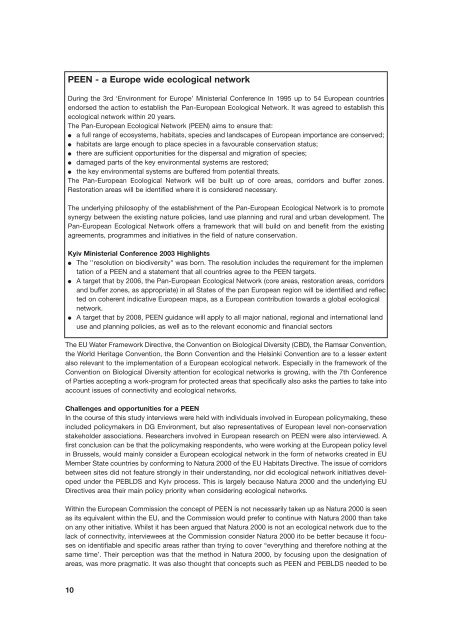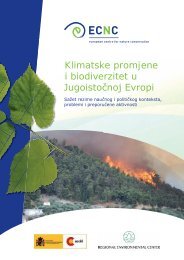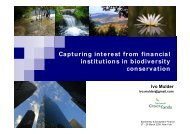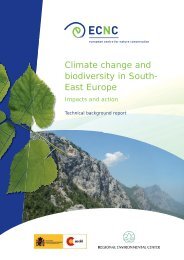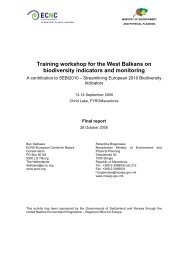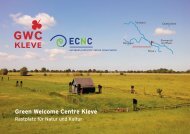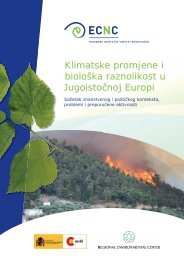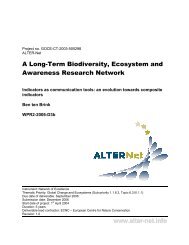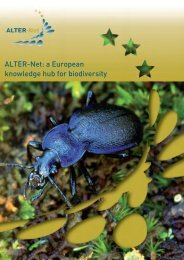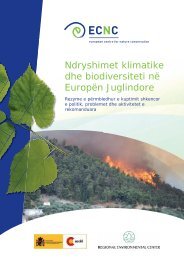2005 - Communicating the Pan-European Ecological Network - ECNC
2005 - Communicating the Pan-European Ecological Network - ECNC
2005 - Communicating the Pan-European Ecological Network - ECNC
Create successful ePaper yourself
Turn your PDF publications into a flip-book with our unique Google optimized e-Paper software.
PEEN - a Europe wide ecological networkDuring <strong>the</strong> 3rd ‘Environment for Europe’ Ministerial Conference In 1995 up to 54 <strong>European</strong> countriesendorsed <strong>the</strong> action to establish <strong>the</strong> <strong>Pan</strong>-<strong>European</strong> <strong>Ecological</strong> <strong>Network</strong>. It was agreed to establish thisecological network within 20 years.The <strong>Pan</strong>-<strong>European</strong> <strong>Ecological</strong> <strong>Network</strong> (PEEN) aims to ensure that:● a full range of ecosystems, habitats, species and landscapes of <strong>European</strong> importance are conserved;● habitats are large enough to place species in a favourable conservation status;● <strong>the</strong>re are sufficient opportunities for <strong>the</strong> dispersal and migration of species;● damaged parts of <strong>the</strong> key environmental systems are restored;● <strong>the</strong> key environmental systems are buffered from potential threats.The <strong>Pan</strong>-<strong>European</strong> <strong>Ecological</strong> <strong>Network</strong> will be built up of core areas, corridors and buffer zones.Restoration areas will be identified where it is considered necessary.The underlying philosophy of <strong>the</strong> establishment of <strong>the</strong> <strong>Pan</strong>-<strong>European</strong> <strong>Ecological</strong> <strong>Network</strong> is to promotesynergy between <strong>the</strong> existing nature policies, land use planning and rural and urban development. The<strong>Pan</strong>-<strong>European</strong> <strong>Ecological</strong> <strong>Network</strong> offers a framework that will build on and benefit from <strong>the</strong> existingagreements, programmes and initiatives in <strong>the</strong> field of nature conservation.Kyiv Ministerial Conference 2003 Highlights● The ''resolution on biodiversity" was born. The resolution includes <strong>the</strong> requirement for <strong>the</strong> implementation of a PEEN and a statement that all countries agree to <strong>the</strong> PEEN targets.● A target that by 2006, <strong>the</strong> <strong>Pan</strong>-<strong>European</strong> <strong>Ecological</strong> <strong>Network</strong> (core areas, restoration areas, corridorsand buffer zones, as appropriate) in all States of <strong>the</strong> pan <strong>European</strong> region will be identified and reflected on coherent indicative <strong>European</strong> maps, as a <strong>European</strong> contribution towards a global ecologicalnetwork.● A target that by 2008, PEEN guidance will apply to all major national, regional and international landuse and planning policies, as well as to <strong>the</strong> relevant economic and financial sectorsThe EU Water Framework Directive, <strong>the</strong> Convention on Biological Diversity (CBD), <strong>the</strong> Ramsar Convention,<strong>the</strong> World Heritage Convention, <strong>the</strong> Bonn Convention and <strong>the</strong> Helsinki Convention are to a lesser extentalso relevant to <strong>the</strong> implementation of a <strong>European</strong> ecological network. Especially in <strong>the</strong> framework of <strong>the</strong>Convention on Biological Diversity attention for ecological networks is growing, with <strong>the</strong> 7th Conferenceof Parties accepting a work-program for protected areas that specifically also asks <strong>the</strong> parties to take intoaccount issues of connectivity and ecological networks.Challenges and opportunities for a PEENIn <strong>the</strong> course of this study interviews were held with individuals involved in <strong>European</strong> policymaking, <strong>the</strong>seincluded policymakers in DG Environment, but also representatives of <strong>European</strong> level non-conservationstakeholder associations. Researchers involved in <strong>European</strong> research on PEEN were also interviewed. Afirst conclusion can be that <strong>the</strong> policymaking respondents, who were working at <strong>the</strong> <strong>European</strong> policy levelin Brussels, would mainly consider a <strong>European</strong> ecological network in <strong>the</strong> form of networks created in EUMember State countries by conforming to Natura 2000 of <strong>the</strong> EU Habitats Directive. The issue of corridorsbetween sites did not feature strongly in <strong>the</strong>ir understanding, nor did ecological network initiatives developedunder <strong>the</strong> PEBLDS and Kyiv process. This is largely because Natura 2000 and <strong>the</strong> underlying EUDirectives area <strong>the</strong>ir main policy priority when considering ecological networks.Within <strong>the</strong> <strong>European</strong> Commission <strong>the</strong> concept of PEEN is not necessarily taken up as Natura 2000 is seenas its equivalent within <strong>the</strong> EU, and <strong>the</strong> Commission would prefer to continue with Natura 2000 than takeon any o<strong>the</strong>r initiative. Whilst it has been argued that Natura 2000 is not an ecological network due to <strong>the</strong>lack of connectivity, interviewees at <strong>the</strong> Commission consider Natura 2000 ito be better because it focuseson identifiable and specific areas ra<strong>the</strong>r than trying to cover “everything and <strong>the</strong>refore nothing at <strong>the</strong>same time’. Their perception was that <strong>the</strong> method in Natura 2000, by focusing upon <strong>the</strong> designation ofareas, was more pragmatic. It was also thought that concepts such as PEEN and PEBLDS needed to be10


